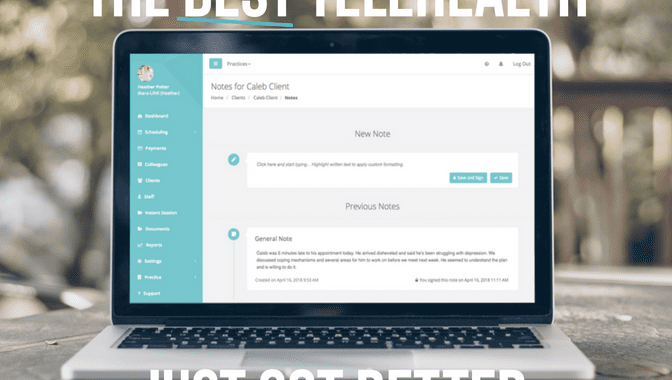What is the Difference Between Telehealth and Telemedicine?
What is the difference between telehealth and telemedicine? Most providers should be familiar with these two terms. Virtual visits have boomed in popularity over the last few years, especially since the start of the COVID-19 pandemic. The transition to digital has removed barriers to care for clients and patients all across the country while also keeping people safe from communicable diseases. When talking about virtual visits, the terms telehealth and telemedicine are thrown around quite a bit. So what is the difference between telehealth and telemedicine?
What is Telehealth?
Telehealth is the most commonly used term and it refers to the delivery and distribution of services and information through telecommunication technology. In other words, telehealth refers to visits that take place over the phone, video visits, and other forms of digital communications.
For example, when a client calls to schedule a telehealth visit with their therapist, they can expect to schedule a phone call or video conference with them. Telehealth is not limited to the medical profession as it is also used by non-clinical providers such as therapists or counselors. Telehealth is the broad umbrella of delivering information digitally, over the internet. Whether something is considered a telehealth tool or not depends on the legal definition of telecommunication technology.
In the United States, approved technologies can include videoconferencing, the internet, store-and-forward imaging, streaming media, and landline/wireless communications. Some payers have restrictions on what telehealth technology they approve for use.
What is Telemedicine?
So how is telemedicine different? Many use the two terms interchangeably without really knowing the difference between telehealth and telemedicine. Where telehealth refers to the delivery of health information via telecommunication technology, telemedicine refers to its clinical use. This narrowed-down branch of telehealth refers more specifically to the use of this technology to deliver care to patients from separate locations.
What are the Differences Between Telehealth and Telemedicine?
To clarify, the difference between telehealth and telemedicine is that telehealth includes all remote care services, including telemedicine. Telemedicine refers specifically to remote clinical healthcare.
How Can Providers Benefit from a Quality Solution?
Now that we understand the difference between the two, what else should providers take note of? Not every telehealth solution is the same, and it is important that your organization adopts technology that will effectively support it for years to come. Features of a quality telehealth solution include:
- Custom Waiting Room: Providers can add a personal touch to their client’s waiting experience by choosing customizable images, music, and more.
- Permissions: Patients won’t be able to enter the visit until you let them. You can even require your client to complete their payment before they can enter the visit.
- Group Sessions: Need a way to host remote group sessions? A quality telehealth solution will make it easy for everyone to see one another, just as they would in person.
- Beautiful Video Quality: Creating a positive experience is a huge priority for therapists offering telehealth visits. Make sure to find software that prioritizes video quality so you can see your clients and they can see you.
- Easy Implementation: You do not have time to fiddle with complicated software. Your organization needs a tool that is easy to implement so you can get right to work.
Benefits of Telehealth:
Once you have found a solution worth using, you can start to reap the benefits that come with offering telehealth. Those benefits include but are not limited to:
- Eliminate Barriers to Care: Patients do not always have transportation to and from their provider’s office. Others do not always have time in their workday to stop and drive to prioritize their mental health. There are dozens of barriers to mental and behavioral health care that have limited individuals from seeking the care they need. Telehealth eliminates a huge amount of those barriers by allowing individuals to log in and see their providers online.
- Keep Clients Safe: As long as the pandemic is still in effect, there will be a need to keep clients safe, especially those who are more vulnerable to the effects of the disease. Telehealth offers a safe method for vulnerable individuals to continue to receive services.
- Improved Engagement: Clients are more likely to continue their care when it is easy to access. Telehealth can help increase client engagement and keep them coming back.
- Improves Satisfaction: Clients are more comfortable at home than they are in your office. They are more likely to feel at peace working with their provider from a space in which they are comfortable, open up about more, and be happy with their care.
There are many reasons to add a quality telehealth solution to your practice toolbelt. From eliminating barriers to care to improving satisfaction, your practice and your clients will benefit from it.







